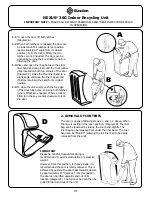
Only operate the machine while in the operator's seat. Securely connect the seat belt while operating the
machine. Only operate the controls while the engine is operating.
Do a check for the correct operation of all the controls and the protective devices.
As a warning operate the horn two times to tell others in the area to prevent personal injury because of
machine movement.
During operation of the machine, record damage and make necessary repairs.
A rollover of the machine can occur when doing work on hills, banks, or slopes. A rollover of the machine
can also occur when operating across ditches, ridges, or other unanticipated blockages.
Hold the implement approximately 40 cm (16 in) above the ground level while operating the machine. Do
not operate the machine near an overhang, near the edge of a cliff, or near edge of an excavation.
If the machine starts to sideslip on a grade, immediately decrease the load and turn machine downhill.
Be careful to prevent ground conditions which will cause the machine to rollover.
Keep the machine in control. Do not overload the machine more than the capacity.
Make sure the towing devices are sufficient for the work.
Make sure the components on the 3-point linkage are sufficient for the work.
Connect the trailing equipment only to a drawbar or hitch.
Do not straddle a wire cable.
When maneuvering to connect equipment, make sure no personnel are between machine and trailing
equipment. Hold up the hitch of trailing equipment to align equipment with drawbar.
Know the maximum dimensions of the machine.
When operating on icy or muddy roads, decrease the travel speed to prevent the loss of control of
machine.
After operating in muddy conditions, let sufficient time for tracks to reject unwanted material and moisture
before making high speed maneuvers. Belts that are wet and belts that are muddy can impede machine's
steering.
Decrease travel speed if the stability of the machine is noticeably reduced.
Slow the machine to a speed that controls the machine when declining a hill.
Use the service brakes if necessary, to control machine speed. Do not coast down a hill with transmission
in neutral.
Do not steer machine when crossing ditches. Ditches that are wide and/or ditches that are deep can let
the guide blocks sag below midwheels. This can cause the belt to come off.
Do not let passengers anywhere on the machine but on an approved passenger seat. Instructors must
have the instructor seatbelt securely connected during all operation.
1.1.17 Parking
Make sure to park the machine on a solid, level surface. Move the drive lever to the neutral position. Wait
a time for the park brake to automatically engage or press the park brake switch on the multifunction
armrest. Lower all implements to the ground. Move the throttle control lever to low idle and wait a time to
let the turbocharger cool. Stop the engine and take the key with you.
1.1.18 Operator station
Do not drill holes or weld on the cab rollover protective structure. (ROPS)
Any modifications to the inner operator station must not extend into the operator space.
Any item brought into the cab must not extend into defined operator space. Secure loose items. Objects
must not pose an impact hazard in rough terrain or if there is a rollover.
GUID-4571C9DD-C7B0-45F6-B234-9FFCE6DC789B [V1]
GUID-8E29B67F-A956-4F31-997B-8035E2F7CE16 [V2]
1. General
Rubber Track Tractor
1-9
79037272A





































